Semi-Annual Climate Modes in the Western Hemisphere
Abstract
1. Introduction
- (i)
- Equatorial convection patterns, which exhibit bi-annual maxima associated with solar zenith passages [4];
- (ii)
- (iii)
- Phase lags in the upper-ocean thermal response, where oceanic mixed layers adjust to surface fluxes with delays governed by depth and stratification [7];
- (iv)
- Coupled variations in solar radiation, air–sea fluxes, and mixed-layer depth, particularly in equatorial regions [8];
- (v)
- Bifurcation of subtropical jet streams and formation of cutoff lows, which are linked to spring and autumn peaks in baroclinic instability [9].
2. Data and Methods
3. Results
3.1. Semi-Annual EOF Mode of Space-Time Character
3.2. Background Conditions Supporting Semi-Annual Modes
3.3. Characterizing the Inter-Annual Residual
3.4. Composite Anomalies and Inferences
4. Concluding Discussion
Funding
Data Availability Statement
Acknowledgments
Conflicts of Interest
Appendix A
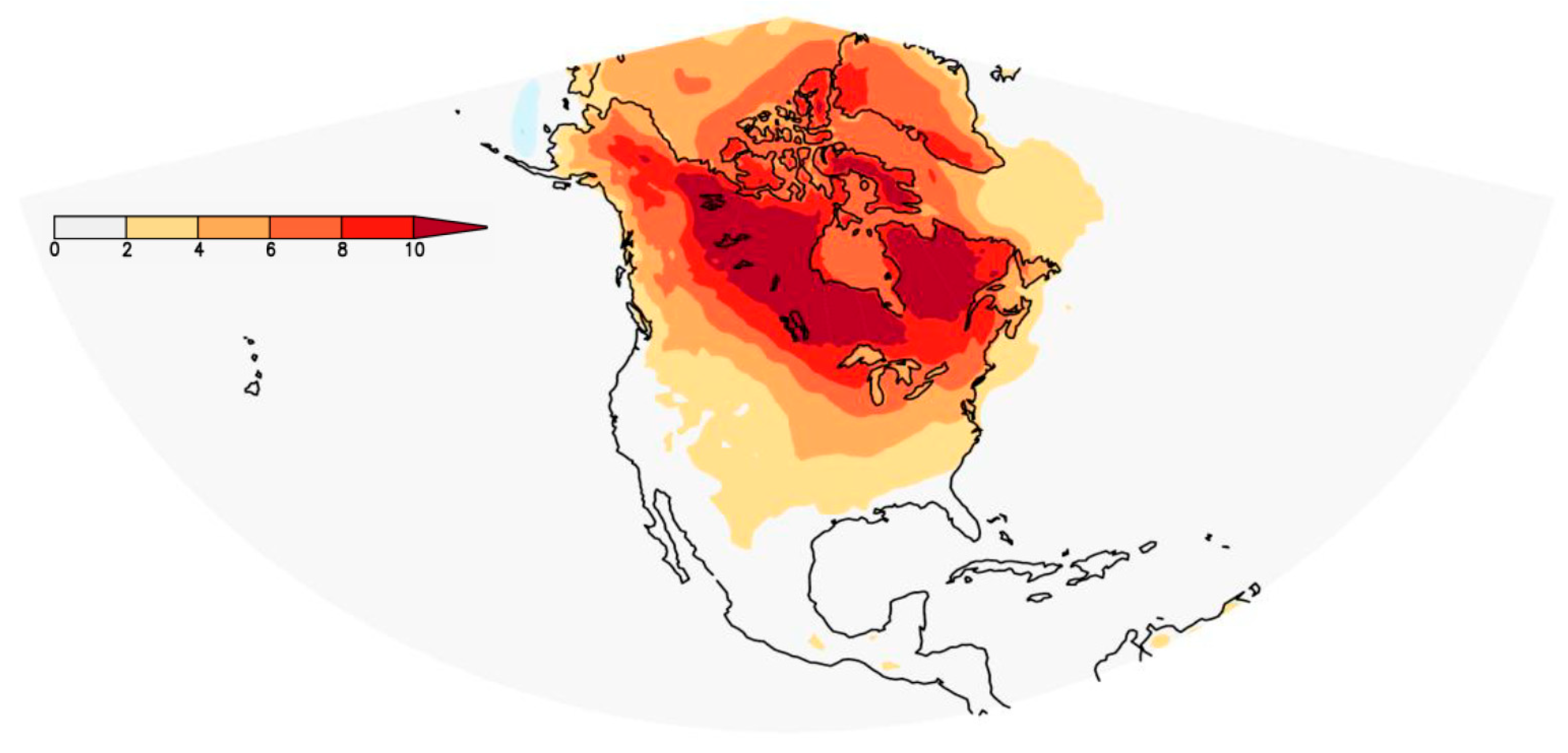
References
- Pezzulli, S.; Stephenson, D.B.; Hannachi, A. The variability of seasonality. J. Clim. 2005, 18, 71–88. [Google Scholar] [CrossRef]
- Donohoe, A.; Battisti, D.S. The seasonal cycle of atmospheric heating and temperature. J. Clim. 2013, 26, 4962–4980. [Google Scholar] [CrossRef]
- Cleland, E.E.; Chuine, I.; Menzel, A.; Mooney, H.A.; Schwartz, M.D. Shifting plant phenology in response to global change. Trends Ecol. Evol. 2007, 22, 357–365. [Google Scholar] [CrossRef] [PubMed]
- Jury, M.R.; Mpeta, E.J. The annual cycle of climate over Africa and its variability. Water SA 2005, 31, 1–8. [Google Scholar] [CrossRef][Green Version]
- Fang, M.; Tung, K.K. Time-dependent nonlinear Hadley circulation. J. Atmos. Sci. 1999, 56, 1797–1807. [Google Scholar] [CrossRef]
- Dima, I.M.; Wallace, J.M. On the seasonality of the Hadley Cell. J. Atmos. Sci. 2003, 60, 1522–1527. [Google Scholar] [CrossRef]
- McKinnon, K.; Stine, A.; Huybers, P. The spatial structure of the annual cycle in surface temperature: Amplitude, phase and lagrangian history. J. Clim. 2013, 26, 7852–7862. [Google Scholar] [CrossRef]
- Yang, F.; Wu, Z. On the physical origin of the semi-annual component of surface air temperature over oceans. Clim. Dyn. 2022, 59, 2137–2149. [Google Scholar] [CrossRef]
- Pinheiro, H.R.; Hodges, K.I.; Gan, M.A. Deepening mechanisms of cut-off lows in the southern hemisphere and the role of jet-streams: Insights from eddy kinetic energy analysis. Weather Clim. Dyn. 2024, 5, 881–894. [Google Scholar] [CrossRef]
- White, W.B. Tropical coupled Rossby waves in the Pacific ocean–atmosphere system. J. Phys. Oceanogr. 2000, 30, 1245–1264. [Google Scholar] [CrossRef]
- Jury, M.R. MJO influence in the Caribbean. Theor. Appl. Climatol. 2019, 138, 1559–1567. [Google Scholar] [CrossRef]
- Donohoe, A.; Dawson, E.; McMurdie, L.; Battisti, D.S.; Rhines, A. Seasonal asymmetries in the lag between insolation and surface temperature. J. Clim. 2020, 33, 3921–3945. [Google Scholar] [CrossRef]
- North, J.S.; Schliep, E.M.; Wikle, C.K. On the spatial and temporal shift in the archetypal seasonal temperature cycle as driven by annual and semi-annual harmonics. Environmetrics 2021, 32, e2665. [Google Scholar] [CrossRef]
- Song, Y.; Lawlor, K.B.; Witten, T.A. Excess semiannual variation in historical temperature records. Qtr. J. Roy. Meteo. Soc. 2021, 147, 764–772. [Google Scholar] [CrossRef]
- Adam, O. Dynamic and energetic constraints on the modality and position of the inter-tropical convergence zone in an aquaplanet. J. Clim. 2021, 34, 527–543. [Google Scholar] [CrossRef]
- Liu, X.; Grise, K.M.; Schmidt, D.F.; Davis, R.E. Regional characteristics of variability in the Northern Hemisphere wintertime polar front jet and subtropical jet in observations and CMIP6 models. J. Geophys. Res. Atmos. 2021, 126, e2021JD034876. [Google Scholar] [CrossRef]
- Gelaro, R.; McCarty, W.; Suárez, M.J.; Todling, R.; Molod, A.; Takacs, L.; Randles, C.A.; Darmenov, A.; Bosilovich, M.G.; Reichle, R.; et al. The modern-era retrospective analysis for research and applications, version 2 (MERRA-2). J. Clim. 2017, 30, 5419–5454. [Google Scholar] [CrossRef]
- Adler, R.F.; Sapiano, M.; Wang, J.-J. Global Precipitation Climatology Project (GPCP) Monthly Analysis. NASA technical paper: CDRP-ATBD-0848; NASA: Washington, DC, USA, 2016; p. 32. [Google Scholar]
- Rayner, N.A.; Parker, D.E.; Horton, E.B.; Folland, C.K.; Alexander, L.V.; Rowell, D.P.; Kent, E.C.; Kaplan, A. Global analyses of sea surface temperature, sea ice, and night marine air temperature since the late nineteenth century. J. Geophys. Res. 2003, 108, 4407. [Google Scholar] [CrossRef]
- Ambaum, M.H.; Hoskins, B.J.; Stephenson, D.B. Arctic oscillation or north Atlantic oscillation? J. Clim. 2001, 14, 3495–3507. [Google Scholar] [CrossRef]
- Penny, S.G.; Behringer, D.W.; Carton, J.A.; Kalnay, E. The hybrid global ocean data assimilation system at NCEP. Mon. Wea. Rev. 2015, 143, 4660–4677. [Google Scholar] [CrossRef]
- Ding, H.; Keenlyside, N.; Latif, M. Impact of the equatorial Atlantic on the El Niño Southern Oscillation. Clim. Dyn. 2012, 38, 1965–1972. [Google Scholar] [CrossRef]
- Whitewood, R.; Phillips, D. Regional Climates (Canada), in State of the Climate in 2010. Bull. Amer. Meteo. Soc. 2011, 92, S173–175. [Google Scholar]
- Wang, B. Interdecadal changes in El Niño onset in the last four decades. J. Clim. 1995, 8, 267–285. [Google Scholar] [CrossRef]
- Wang, C. ENSO, Atlantic climate variability, and the Walker and Hadley circulations. In The Hadley Circulation: Present, Past and Future; Diaz, H.F., Bradley, R.S., Eds.; Kluwer: Alphen aan den Rijn, The Netherlands, 2005; pp. 173–202. [Google Scholar]
- Chen, S.; Chen, W.; Wu, R.; Yu, B.; Graf, H.-F.; Cai, Q.; Ying, J.; Xing, W. Atlantic multidecadal variability controls Arctic-ENSO connection. Nature Clim. Atmos. Sci. 2025, 8, 44. [Google Scholar] [CrossRef]
- Mullens, S.R. Increasingly undulatory jet-streams. In Proceedings of the 26th Conference on Climate Variability and Change (AMS), Atlanta, GA, USA, 3 February 2014. [Google Scholar]

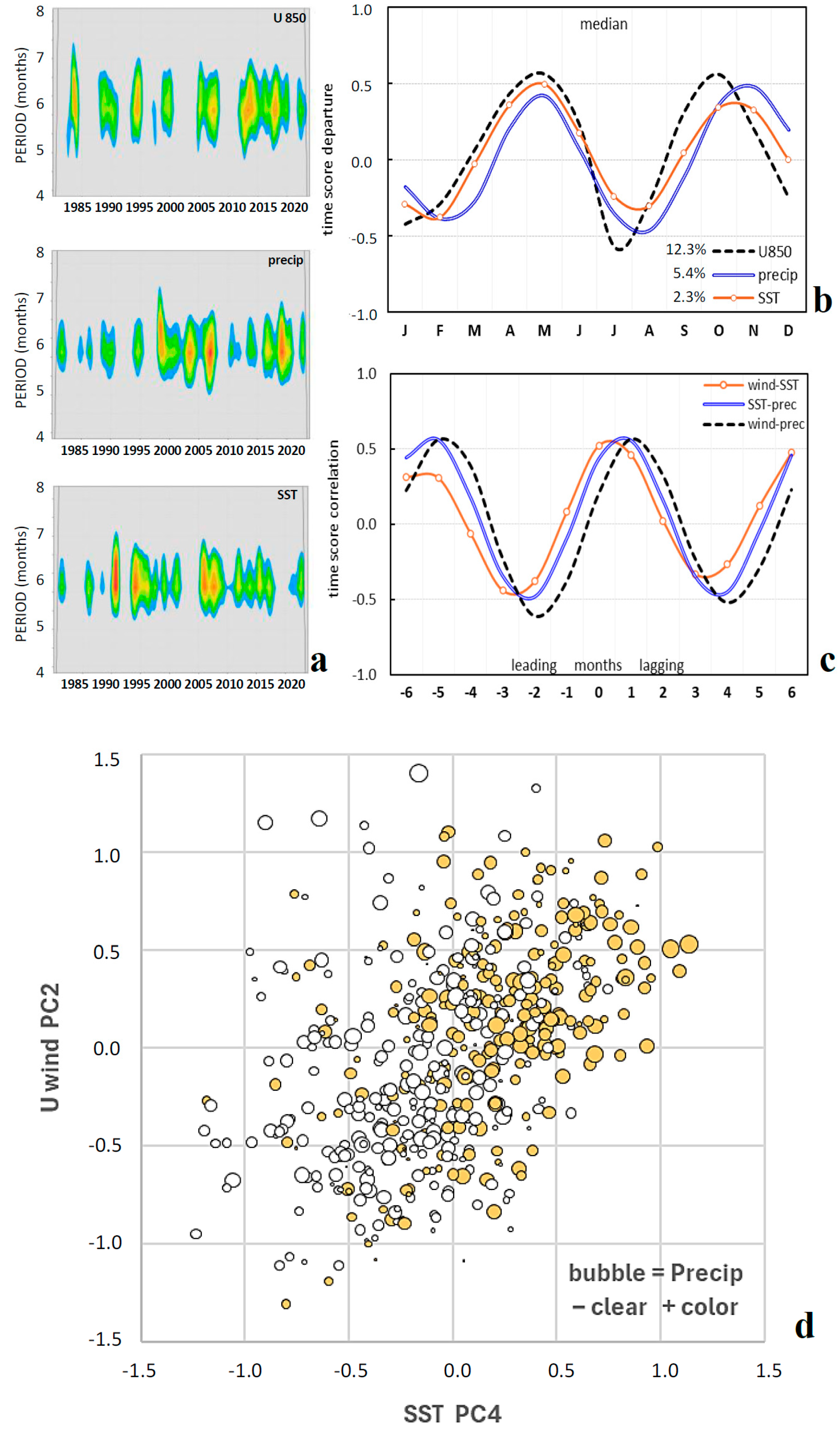
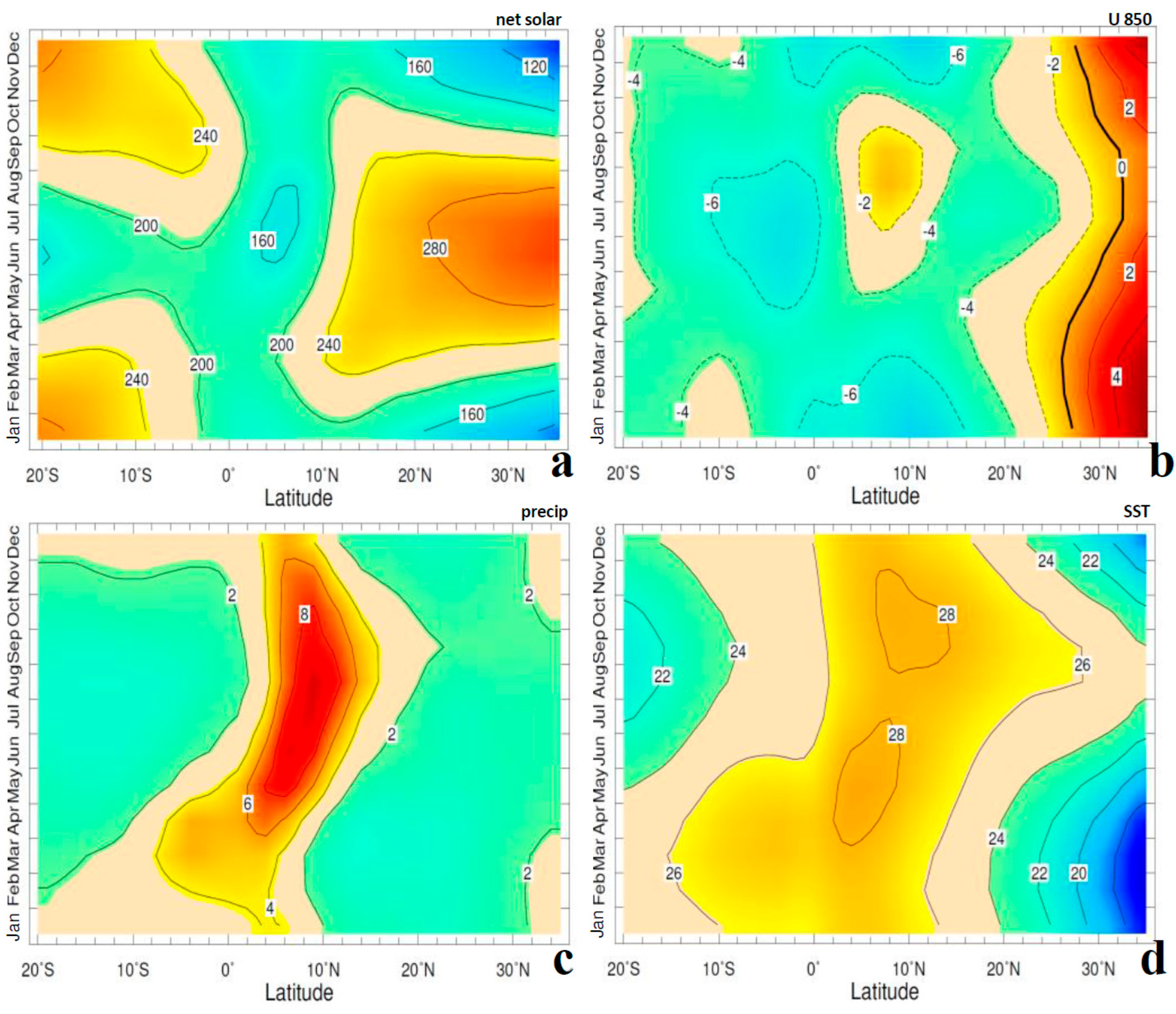

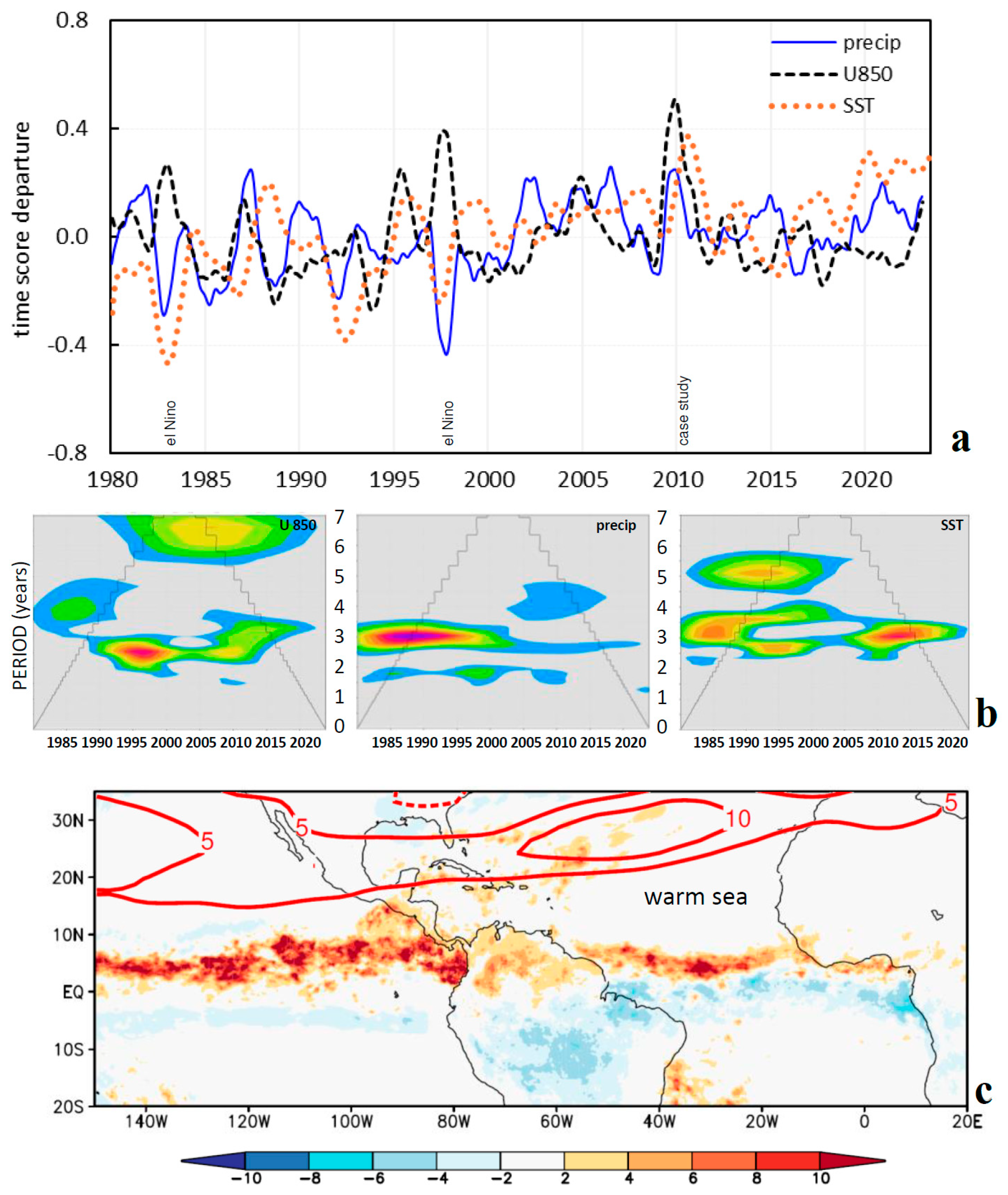
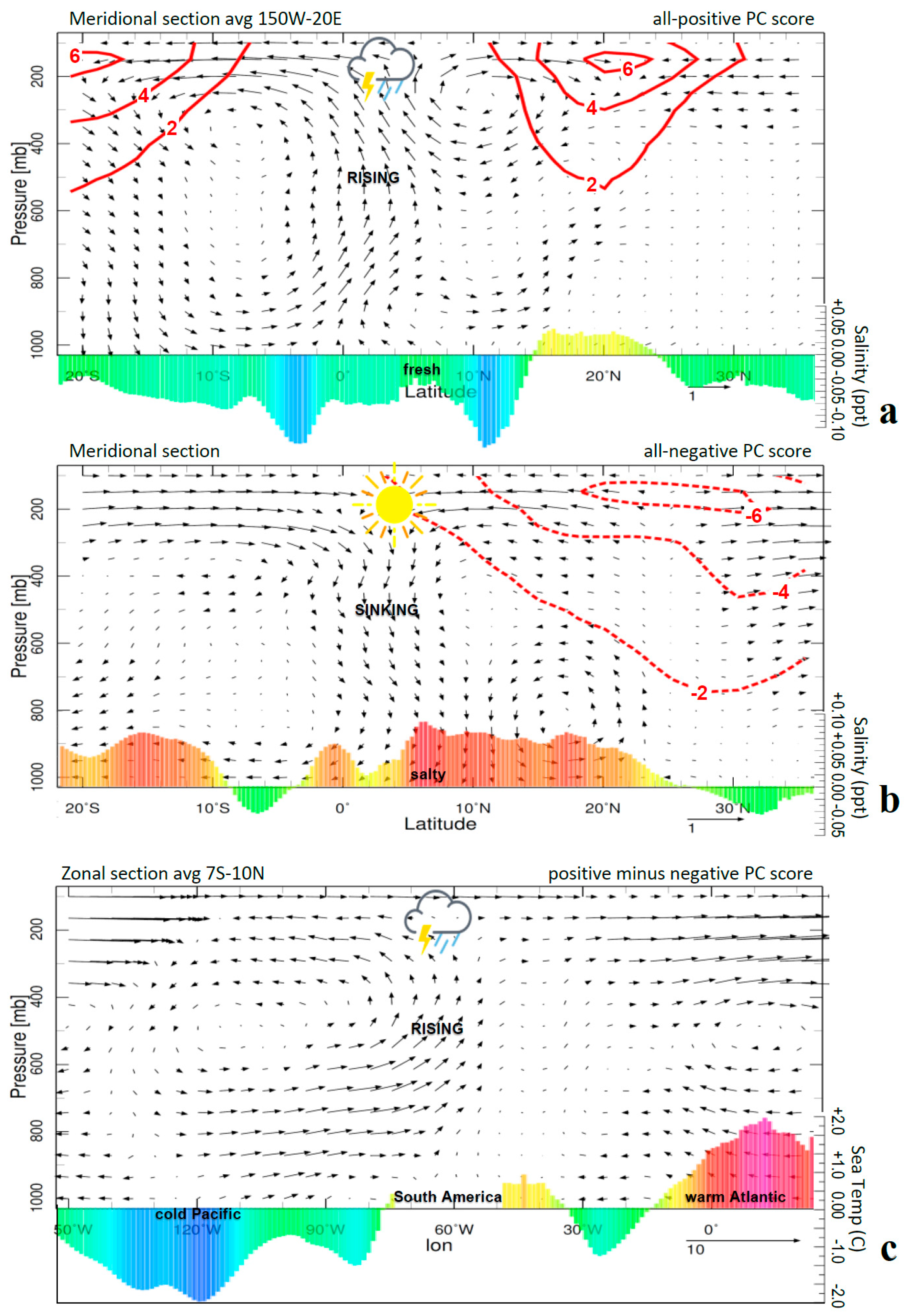
Disclaimer/Publisher’s Note: The statements, opinions and data contained in all publications are solely those of the individual author(s) and contributor(s) and not of MDPI and/or the editor(s). MDPI and/or the editor(s) disclaim responsibility for any injury to people or property resulting from any ideas, methods, instructions or products referred to in the content. |
© 2025 by the author. Licensee MDPI, Basel, Switzerland. This article is an open access article distributed under the terms and conditions of the Creative Commons Attribution (CC BY) license (https://creativecommons.org/licenses/by/4.0/).
Share and Cite
Jury, M.R. Semi-Annual Climate Modes in the Western Hemisphere. Climate 2025, 13, 111. https://doi.org/10.3390/cli13060111
Jury MR. Semi-Annual Climate Modes in the Western Hemisphere. Climate. 2025; 13(6):111. https://doi.org/10.3390/cli13060111
Chicago/Turabian StyleJury, Mark R. 2025. "Semi-Annual Climate Modes in the Western Hemisphere" Climate 13, no. 6: 111. https://doi.org/10.3390/cli13060111
APA StyleJury, M. R. (2025). Semi-Annual Climate Modes in the Western Hemisphere. Climate, 13(6), 111. https://doi.org/10.3390/cli13060111





